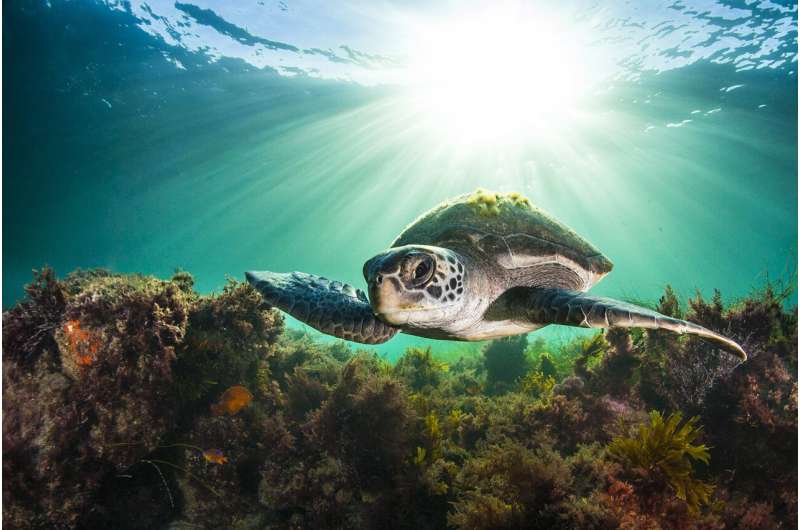This article has been reviewed according to Science X's editorial process and policies. Editors have highlighted the following attributes while ensuring the content's credibility:
fact-checked
peer-reviewed publication
trusted source
proofread
Surprises in sea turtle genes could help them adapt to a rapidly changing world

Around 100 million years ago, a group of land-dwelling turtles took to the oceans, eventually evolving into the sea turtles that we know today. However, the genetic foundations that have enabled them to thrive in oceans throughout the world have remained largely unknown.
In research recently published in the Proceedings of the National Academy of Sciences, an international team of 48 researchers led by the University of Massachusetts Amherst, in collaboration with the Leibniz Institute for Zoo and Wildlife Research and the Vertebrate Genome Project, revealed an incredibly detailed genetic map of two species—green and leatherback turtles—that is packed with surprises that might hold the key to their survival in a rapidly changing world.
The genome of a single species contains the genetic set of instructions used to build that species, and sequencing the genome of any species is an enormous amount of work. This is akin to translating an entire library into a language that scientists can read, and has only been possible in the last few decades. For green sea turtles, a "draft" genome, including approximately 100,000 pieces of genetic information, has been available since 2013.
"But," says Blair Bentley, a postdoctoral researcher in environmental conservation at UMass Amherst and the lead author of the new research, "these pieces of genetic information weren't precisely mapped out. It was as if you walked into a library and found 100,000 pages lying on the floor."
To more precisely catalogue the turtles' genomes, the international team turned to new technologies including long read sequencing—a technique recently named 2022 Method of the Year by the journal Nature. This has made it possible to sequence genomes from virtually any living species and to do so with far more accuracy than was previously possible.
Sequencing of the turtles' genomes was performed both at Rockefeller University, in the Vertebrate Genome Laboratory (VGL), led by Erich Jarvis, who chairs the VGP, and Olivier Fedrigo who is director of the VGL, and at the Max Planck Institute of Molecular Cell Biology and Genetics by Eugene Myers—all co-authors on the new study. "These advances allowed us to do the equivalent of shelving everything according to the Dewey Decimal System so that we can begin to understand how everything fits together," says Bentley.
Once Bentley and his co-authors had correctly organized and annotated the genetic data, they started finding surprises. The first is that, though greens and leatherbacks diverged from a common ancestor about 60 million years ago, their genomes are remarkably similar.
Similar, but not the same. "It's those differences that make them unique," says Lisa Komoroske, professor of environmental conservation at UMass and one of the paper's two senior authors. And it's those differences that may hold the key to each species' long-term survival, especially considering that populations of both greens and leatherbacks have seen precipitous declines due to human activity.
It turns out that green turtles have evolved more genes dedicated to immunity, suggesting an immune system that is better prepared for new pathogens; as well as more olfactory receptors—they have better senses of smell. The leatherback genome also shows that they lower genetic diversity and have historically had lower population levels.
"This is both a blessing and a curse," says Komoroske, "because it means that while leatherbacks are a resilient species, there isn't much genetic diversity for them to evolve to meet the challenges of their rapidly changing environment." Insights such as these will help conservation biologists make more informed decisions about how best to protect these animals as they face the challenges of adapting to our rapidly changing planet.
Furthermore, the more time Bentley and Komoroske spent in the turtles' genomes, the more it became clear that much of the genetic difference between the two species is to be found not on the macrochromosomes, but on what was once considered to be "genetic junk": microchromosomes, or small genetic bits that seem not to exist in mammals but are characteristic of avian and reptilian genomes.
"We found most of the divergences between the green and the leatherbacks on these microchromosomes," says Camila Mazzoni, a researcher at the Leibniz Institute for Zoo and Wildlife Research and the study's other senior author, "and our work feeds into the growing scholarship on the importance of microchromosomes in vertebrate evolution."
More information: Blair P. Bentley et al, Divergent sensory and immune gene evolution in sea turtles with contrasting demographic and life histories, Proceedings of the National Academy of Sciences (2023). DOI: 10.1073/pnas.2201076120
Journal information: Proceedings of the National Academy of Sciences , Nature
Provided by University of Massachusetts Amherst



















